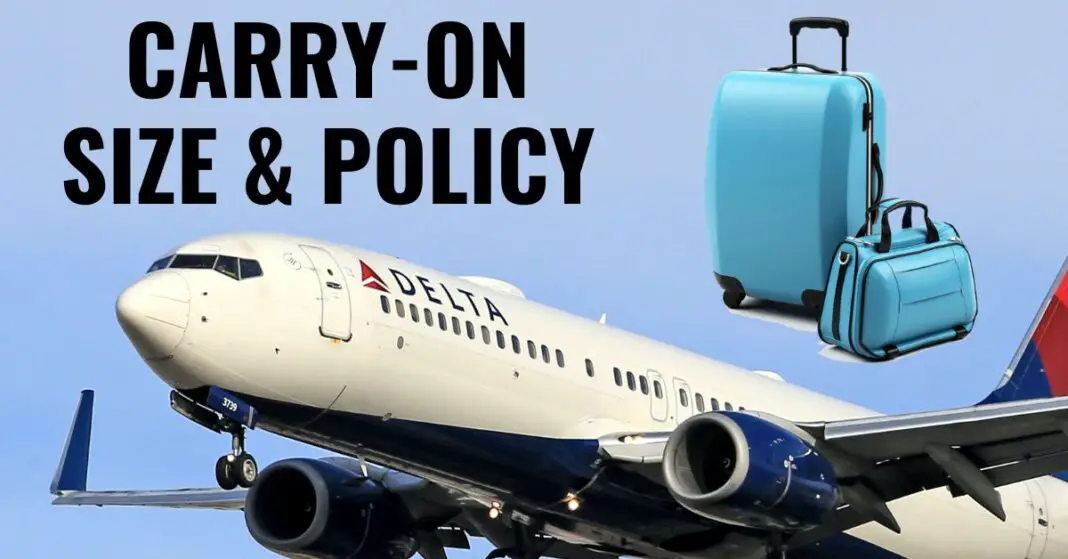Navigating the often complex and varying baggage policies of airlines can be a daunting task for many travelers. One of the key players in the aviation industry, Delta Air Lines, has its own unique set of rules and specifications when it comes to carry-on baggage. Understanding these policies, as well as how they compare and contrast with other major airlines’ baggage policies, can greatly assist in making your travel experience smoother and more enjoyable.
Furthermore, mastering the art of packing efficiently can not only ensure you comply with all baggage size regulations, but can also provide you with everything you need for your trip without compromising space or incurring additional fees.
Table of Contents
Understanding Delta’s baggage policy
Traveling for business or pleasure is a regular part of the entrepreneurial lifestyle, with every opportunity providing us with a chance to scout new talent or explore emerging markets. However, navigating the varied and sometimes complex rules around airline’s baggage policies can be grueling. Today, let’s simplify the process as we dive into one such policy: Delta’s baggage policy.
Delta Airlines draws a strict line when it comes to its baggage policy— but being business savvy, we know that with complete understanding comes a golden chance to navigate the system efficiently, saving time and resources.
First things first, always remember that the size and weight of your baggage are critical factors when planning your trip. Delta allows one carry-on bag and one personal item free of charge for all ticket classes. Your carry-on bag should not exceed 45 linear inches, which includes 22″ x 14″ x 9″ measurements for length, width, and height respectively. This includes any handles or wheels attached to the bag.
Furthermore, maintaining your baggage’s weight is equally essential. For all flights, Delta has set a limit of 50lbs (23kg) for checked baggage, with a combined total dimension of 62 inches (157cm). Passengers exceeding these limits may be subject to extra charges.
One of the features that sets Delta apart is its policy on checking unique and special items. Whether it’s your state-of-the-art golf clubs or a large painting that caught your fancy in an overseas art gallery, Delta has a flexible policy that can accommodate most non-standard baggage within certain limits.
Moreover, Delta SkyMiles Medallion® Members and Delta Sky Club Members enjoy an enhanced baggage policy. As an entrepreneur always seeking a value proposition, exploring these memberships could unlock immense benefits. If you’re a frequent traveler with Delta, these memberships might be a worthy investment, providing perks such as additional checked baggage without extra fees.
Finally, remember that Delta, like most airlines, updates its baggage policy periodically. Staying ahead and keeping updated about these changes is critical. Delta’s official website always has updated baggage policies, underscoring the importance of doing a quick check before you pack for your next trip.
Navigating the challenges of today’s fast-paced corporate world requires savvy understanding and strategic use of both time and resources. Unraveling Delta’s baggage policy illustrates not only how seemingly mundane matters can directly impact your bottom line, but also the powerful benefits that can be harnessed when we embrace understanding as a strategy in itself. In travel, as in business, decoding the rules is as valuable as enjoying the journey.
Turn your next travel into an advantage by understanding Delta’s baggage policy. Because, dear entrepreneurs, it’s not just about reaching the destination– it’s mastering the journey.
Comparing different airlines’ baggage policies
When assessing business policies, comparison becomes inevitable. Delta Air Lines, recognized globally, holds specific rules about baggage regulation, and as savvy business travelers, it’s crucial to comprehend how it squares up against counterparts.
To start, if what you seek is flexibility, Southwest Airlines might offer a lucrative alternative. Unlike Delta, Southwest grants passengers two free checked bags. This distinctive policy aims to suit customers seeking more accommodating baggage procedures, indicating Southwest’s niche for customer service.
JetBlue, notorious for ample legroom, also shines. The method they employ contradicts Delta’s stringent baggage regulation by permitting one free checked bag on certain high-priced fares. Nonetheless, budget tickets impose charges, falling in line with the industry’s shifting trend towards a la carte pricing, infusing some versatility.
On the opposite side of the spectrum, Spirit Airlines endorses the ‘bare fare’. This business model is cost-effective, only covering transportation and one personal item. All other amenities, including carry-on and checked bags, incur additional costs. While Delta’s policies might seem austere, it’s noteworthy that Spirit might prove pricier for heavy packers.
United and American Airlines, two other key players, match Delta’s restrictive model closely. Like Delta, they refrain from offering free checked bags, except for specific higher-tier fare classes or loyalty program members. Both employ additional charges for overweight or oversized bags, similar to Delta’s policies.
Alaska Airlines, however, partially bucks the trend, boasting one of the best baggage guarantee policies in the industry. If your luggage isn’t at the claim area within 20 minutes, they compensate you with a discount on your next flight, a stark contrast to Delta’s less lenient policy.
Virgin Atlantic, Delta’s transatlantic partner, promises an alliance benefitting Delta SkyMiles Medallion members, enabling the baggage perks on transatlantic routes. A wise tactic for travelers is to exploit this alliance to offset Delta’s unyielding regulations.
In the field of business, ensuring we’re maximizing our resources extends to considering airline policies. By differentiating these regulations, one can adapt to new market conditions or take advantage of partnerships. All in all, understanding Delta’s baggage policy in comparison to competitors adds a layer to our strategic arsenal.
Of course, this discourse scratches only the surface of a broader landscape. Navigating the nuances of each airline’s policies remains as crucial as ever in our ever-evolving business world. Keeping abreast of these shifts is not just savvy—it’s essential.
Learning to pack efficiently
Amid the intricacies of airline policies, the prospect of complying with Delta Airlines’ carry-on size limitations may appear daunting. However, a keen eye for strategic organization and efficient packing can simplify this task. Here are some astute entrepreneurial strategies that can help you pack more efficiently.
Firstly, analyze the items you intend to carry. This permits an optimistic parting with items that aren’t absolute necessities for your trip. The key is practicality. For some, this might mean multi-purpose garments while for others, it could mean travel-sized versions of products.
Secondly, mastering some basic geometry is a smart move. How? Simply by optimizing the space within your luggage. The technique of rolling clothes, for instance, not only ensures crease-free garments but also fits more items into your space. Implement a well-formulated plan to pack your luggage strategically, such as placing heavy items at the base for better balance.
Thirdly, invest in smart luggage designs that are closely aligned with Delta’s specified dimensions, a move mirroring savvy business investment. These bags maximize storage with their innovative design while adhering to the airline’s stipulations. This ensures no wastage of space or resources, much like a successful entrepreneurial venture optimizes its resource allocation.
The concept of travel packing cubes also lends itself well to this scenario. Applying another logical business principle – effective compartmentalization, packing cubes allow for highly efficient separation and categorization of carry-on items. This simple travel hack aids in better organization and quicker access to items.
Lastly, don’t overlook the value of carrying a personal item alongside your carry-on. This second piece could be a laptop bag, a purse, or a briefcase. Choose an item that is multifunctional and can hold numerous essentials. Much like a diversified business portfolio, the intent is to augment your carrying possibility with zero added cost.
Knowledge is, indeed, power when it comes to air travel. Being fully informed on Delta’s carry-on baggage policies, as well as those of other airlines, enables you to plan your trip effectively and avoid any unnecessary surprises at the airport.
Moreover, applying effective packing techniques elevates this experience by allowing you to maximize the limited space available within carry-on size restrictions. So, whether your journeys take you across states or continents, arming yourself with an understanding of baggage rules and skills of efficient packing can enable you to travel with confidence and ease.
How strict is Delta with carry-on size?
If you’re traveling on Delta and bringing a carry-on, make sure it conforms to the 22x14x9 inches (56x35x23 cm) size limit, which includes handles and wheels. Adhering to these dimensions will help you avoid any inconvenience of having to gate-check your bag, as Delta is quite stringent about it.
Is a 24 inch suitcase a carry-on Delta?
A 24-inch suitcase doesn’t qualify as a carry-on for Delta Airlines. Delta’s maximum carry-on dimensions are 22 inches in length, 14 inches in width, and 9 inches in height, which includes handles and wheels. If any of these dimensions, including the length exceeding 24 inches, are exceeded, your suitcase is considered too large for carry-on on Delta flights.
Does Delta have a weight limit for carry-on bags?
On most Delta flights, there is typically no weight limit for carry-on bags. This means you’re free to pack your bag to its size capacity (22 inches x 14 inches x 9 inches, including handles and wheels) without the concern of surpassing a weight restriction.
Can I take a backpack and a carry-on with Delta?
Yes! Delta Airlines permits passengers to bring both a carry-on bag and a personal item, such as a backpack, on board their flights at no additional cost. Just ensure that your carry-on adheres to the specified size restrictions of 22 inches x 14 inches x 9 inches, including handles and wheels
Does a backpack count as a carry-on Delta?
Yes, a backpack is counted as a carry-on on Delta flights however, the size limitations of 22 inches x 14 inches x 9 inches must not be exceeded.
How many 3 oz bottles can I take on a plane Delta?
Thanks to the TSA’s 3-1-1 rule, you’re allowed to bring up to nine 3-ounce bottles on board. Picture these travel-sized essentials neatly arranged in a single, transparent quart-sized bag (think Ziploc). Remember, each bottle must contain 3.4 ounces (100 milliliters) or less, so leave those jumbo-sized shampoo bottles at home!





